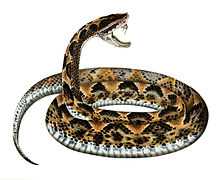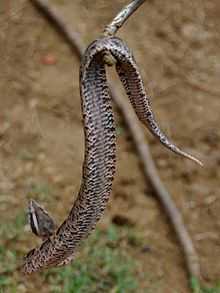Calloselasma
| Calloselasma rhodostoma | |
|---|---|
 | |
| Calloselasma rhodostoma in a 1916 illustration | |
| Conservation status | |
| Scientific classification | |
| Kingdom: | Animalia |
| Phylum: | Chordata |
| Subphylum: | Vertebrata |
| Class: | Reptilia |
| Order: | Squamata |
| Suborder: | Serpentes |
| Family: | Viperidae |
| Subfamily: | Crotalinae |
| Genus: | Calloselasma Cope, 1860 |
| Species: | C. rhodostoma |
| Binomial name | |
| Calloselasma rhodostoma (Kuhl, 1824) | |
| Synonyms | |
| |
- Common names: Malayan ground pit viper,Malayan ground snake,Malayan moccasin,
Calloselasma is a monotypic genus[3] created for a venomous pitviper species, C. rhodostoma, which is endemic to Southeast Asia from Thailand to northern Malaysia and on the island of Java.[2] No subspecies are currently recognized.[4]
Description


Attains an average total length of 76 cm (30 in), with females being slightly longer than males. Occasionally, they may grow as long as 91 cm (36 in).[5]
A specimen with a total length of 81 cm (32 in) has a tail 9 cm (3.5 in) long.
Dorsally it is reddish, grayish, or pale brown, with two series of large, dark brown, black-edged triangular blotches, which are alternating or opposite. There is also a thin dark brown vertebral stripe, which may be interrupted or indistinct in some specimens. The upper labials are pink or yellowish, and powdered with brown. There is a broad, dark brown, black-edged diagonal stripe from the eye to the corner of the mouth, with a narrower light-colored stripe above it. Ventrally it is yellowish, uniform or powdered or spotted with grayish brown.
The smooth dorsal scales are arranged in 21 rows at midbody. Ventrals 138-157; anal plate entire; subcaudals 34-54 pairs.
Snout pointed and upturned. Rostral as deep as broad. Two internasals and two prefrontals. Frontal as long as or slightly longer than its distance from tip of snout, as long as or slightly shorter than the parietals. 7-9 upper labials. Loreal pit not in contact with the upper labials.[6]
This is the only Asian pit viper with large crown scales and smooth dorsal scales.[7]
Geographic range
Found in Nepal, Thailand, Cambodia, Laos, Vietnam, northern West Malaysia and on the Indonesian island of Java. The type locality is listed as "Java".[2] There are unconfirmed, but credible reports from southern Myanmar (Burma), northern Sumatra and northern Borneo.
Habitat and Diet
Prefers coastal forests, bamboo thickets, unused and overgrown farmland, orchards, plantations as well as forests around plantations,[5] where it searches for rats and mice.
Reproduction
This species is oviparous and the eggs are guarded by the female after deposition.[7]
Venom
This species has a reputation for being bad-tempered and quick to strike. In northern Malaysia it is responsible for some 700 incidents of snakebite annually with a mortality rate of about 2 percent. Remarkably sedentary, it has often been found in the same spot several hours after an incident involving humans.[7] Its venom causes severe pain and local swelling and sometimes tissue necrosis, but deaths are not common. Unfortunately many victims are left with dysfunctional or amputated limbs due to the lack of antivenom and early treatment.
See also
- List of crotaline species and subspecies
- Crotalinae by common name
- Crotalinae by taxonomic synonyms
- Snakebite
References
- ↑ http://www.iucnredlist.org/details/192168/0
- ↑ 2.0 2.1 2.2 2.3 McDiarmid RW, Campbell JA, Touré T. 1999. Snake Species of the World: A Taxonomic and Geographic Reference, vol. 1. Herpetologists' League. 511 pp. ISBN 1-893777-00-6 (series). ISBN 1-893777-01-4 (volume).
- ↑ "Calloselasma". Integrated Taxonomic Information System. Retrieved 3 November 2006.
- ↑ "Calloselasma rhodostoma". Integrated Taxonomic Information System. Retrieved 3 November 2006.
- ↑ 5.0 5.1 Mehrtens JM. 1987. Living Snakes of the World in Color. New York: Sterling Publishers. 480 pp. ISBN 0-8069-6460-X.
- ↑ Boulenger, G.A. 1896. Catalogue of the Snakes in the British Museum (Natural History). Volume III., Containing the...Viperidæ... Trustees of the British Museum (Natural History). London. xiv + 727 pp. + Plates I.-XXV. (Ancistrodon rhodostoma, pp. 527-528.)
- ↑ 7.0 7.1 7.2 U.S. Navy. 1991. Poisonous Snakes of the World. US Govt. New York: Dover Publications Inc. 203 pp. ISBN 0-486-26629-X.
Further reading
- Kuhl, H. 1824. Sur les Reptiles de Java. Bull Sci. nat. Géol. 2: 79-83. (Trigonocephalus rhodostoma)
- Warrell DA, Looareesuwan S, Theakston RD et al. (November 1986). "Randomized comparative trial of three monospecific antivenoms for bites by the Malayan pit viper (Calloselasma rhodostoma) in southern Thailand: clinical and laboratory correlations". The American Journal of Tropical Medicine and Hygiene 35 (6): 1235–47. PMID 3538922. Retrieved 2012-08-30.
- Ho M, Warrell DA, Looareesuwan S et al. (May 1986). "Clinical significance of venom antigen levels in patients envenomed by the Malayan pit viper (Calloselasma rhodostoma)". The American Journal of Tropical Medicine and Hygiene 35 (3): 579–87. PMID 3706625. Retrieved 2012-08-30.
- Au LC, Lin SB, Chou JS, Teh GW, Chang KJ, Shih CM (September 1993). "Molecular cloning and sequence analysis of the cDNA for ancrod, a thrombin-like enzyme from the venom of Calloselasma rhodostoma" (PDF). The Biochemical Journal 294 (2): 387–90. PMC 1134466. PMID 8373353. Retrieved 2012-08-30.
- Ponnudurai, G.; Chung, M.C.M.; Tan, N.H. (1994). "Purification and Properties of the L-Amino Acid Oxidase from Malayan Pit Viper (Calloselasma rhodostoma) Venom". Archives of Biochemistry and Biophysics 313 (2): 373–378. doi:10.1006/abbi.1994.1401. ISSN 0003-9861. PMID 8080286.
- Yingprasertchai, Senee; Bunyasrisawat, Srisurat; Ratanabanangkoon, Kavi (2003). "Hyaluronidase inhibitors (sodium cromoglycate and sodium auro-thiomalate) reduce the local tissue damage and prolong the survival time of mice injected with Naja kaouthia and Calloselasma rhodostoma venoms". Toxicon 42 (6): 635–646. doi:10.1016/j.toxicon.2003.09.001. ISSN 0041-0101.
- Ouyang, Chaoho; Yeh, Horng-I; Huang, Tur-Fu (1986). "Purification and characterization of a platelet aggregation inducer from Calloselasma rhodostoma (Malayan pit viper) snake venom". Toxicon 24 (7): 633–643. doi:10.1016/0041-0101(86)90026-7. ISSN 0041-0101.
- Daltry, Jennifer C.; Ross, Toby; Thorpe, Roger S.; Wuster, Wolfgang (1998). "Evidence that humidity influences snake activity patterns: a field study of the Malayan pit viper Calloselasma rhodostoma". Ecography 21 (1): 25–34. doi:10.1111/j.1600-0587.1998.tb00391.x. ISSN 0906-7590.
External links
| Wikimedia Commons has media related to Calloselasma rhodostoma. |
- Calloselasma at the Reptarium.cz Reptile Database. Accessed 9 August 2007.
- Calloselasma at Herpbreeder.com. Accessed 26 September 2006.
- Calloselasma image at Glades Herp. Accessed 9 August 2007.
- C. rhodostoma at Thailand Snakes. Accessed 21 Dec 2014.
